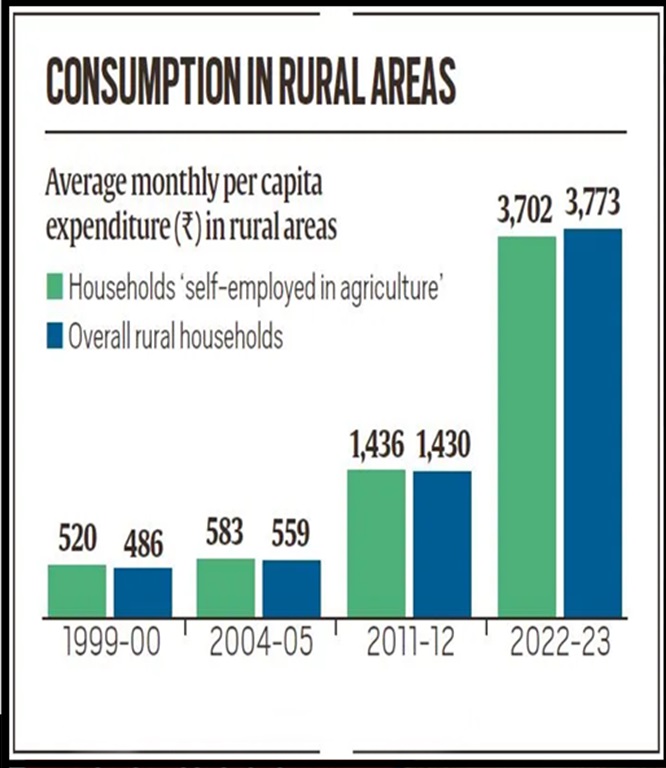A NEW METHODOLOGY BY THE NATIONAL SAMPLE SURVEY (NSS) OFFICE
Syllabus:
- GS 3: Indian Economy and issues relating to planning, mobilization, of resources, growth, development and employment.
Focus:
- (NSS) Office released the key results of the Household Consumption Expenditure Survey (HCES) 2022-23
Source: The Hindu
The National Sample Survey Office’s Household Consumption Expenditure Survey (HCES) for 2022-23 brought forward significant updates in methodology and findings since the last survey in 2011-12. Key highlights include detailed all-India estimates of average monthly per capita consumption expenditure (MPCE) for rural and urban areas, categorized into food and non-food groups. This data fills a decade-long gap, crucial for compiling poverty estimates. However, the shift in methodology, aimed at refining data collection, presents certain issues impacting comparability with past surveys.
NSO
Restructuring and Merger Transformation into NSO
NSSO’s Role and Importance Data Collection
Policy Informer
NSSO-CSO Merger Objective
Expanded Scope
|
Changes and Their Implications
Updated Item Coverage
- Reflecting recent consumption behaviors, the survey broadened its item coverage. This change ensures that current consumer preferences are accurately captured, enhancing the relevance of collected data.
Questionnaire Modification
- Splitting the questionnaire into three parts for food, consumables, and durable goods addressed respondent fatigue and potential under-reporting issues. However, this modification complicates direct comparisons with previous surveys’ data.
Sampling Method Overhaul
- The approach to stratifying villages and urban blocks for sampling shifted from district-based to state/UT-based strata, affecting the representation of smaller districts. Additionally, household stratification criteria were updated, which might not accurately represent states with low ownership of certain assets like four-wheelers.
Stratification of Households
- Adjusting household stratification based on asset ownership (e.g., land or four-wheelers) aims for a more nuanced sample. Nevertheless, the practicality and representativeness of these criteria in reflecting economic diversity within states are contentious.
Methodological Challenges
Non-comparability with Past Surveys
- The altered questionnaire and sampling approach enhance data reliability but hinder comparability with historical data. This disrupts trend analysis, making it challenging to track long-term consumption expenditure patterns.
Addressing Non-comparability
- Proposing an additional survey module that mimics the traditional approach could enable comparability. This involves using a consistent questionnaire and sampling method for a subset of the sample, generating dual estimates for analysis.
Adequate Representation of Wealthy Households
- To better represent high-income households, leveraging administrative data to create a focused sample could improve accuracy. This addresses the low representation of affluent households in states with minimal four-wheeler ownership.
Development of a Comparative Series
- Integrating results from the traditional and revised methodologies could help establish a series of MPCE estimates that are comparable over time, bridging the gap between old and new data sets.
Independent Estimates and Divergence Analysis
- Generating independent estimates for consumption expenditure using both methodologies offers insights into the divergence in data, providing a foundation for a unified, comprehensive consumption expenditure trend line.
While the HCES 2022-23 introduces a more refined methodology, addressing the nuances of modern consumption patterns and improving data reliability, it faces significant challenges. These include issues of comparability with past data, representation of wealthy households, and the practicality of new stratification criteria. Overcoming these challenges requires innovative approaches, such as the development of a comparative series and focused surveys on underrepresented groups. With careful consideration and adjustments, the methodology can evolve to provide accurate, comparable consumption expenditure data crucial for policy-making and economic analysis.
Source:
https://epaper.thehindu.com/reader
Mains Practice Question:
“Analyze the methodological changes introduced in the Household Consumption Expenditure Survey (HCES) 2022-23 by the National Sample Survey Office. Discuss the implications of these changes for data reliability and comparability with previous surveys. Evaluate the challenges posed by these methodological revisions and suggest measures to address them for future surveys to ensure accurate and comparable data collection on household consumption expenditure.”
Associated Articles:
https://universalinstitutions.com/the-sheet-anchor-of-the-fact-sheet/




